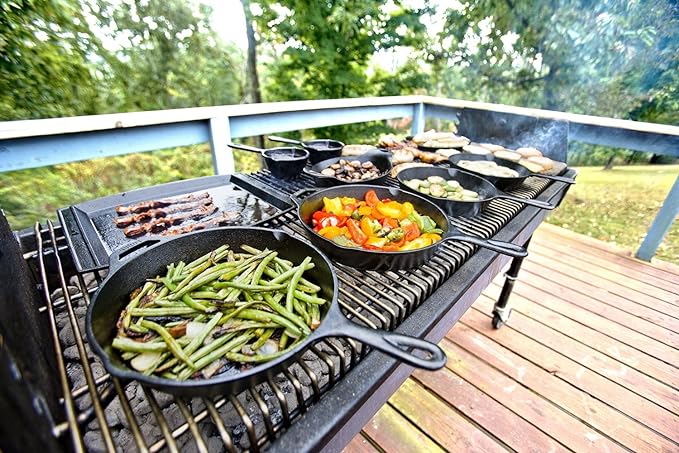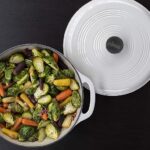The Great Environmental Impact of Different Cookware Materials: Making Sustainable Choices in 2024

Let’s chat about something often overlooked in our kitchens: the environmental impact of different cookware materials. We focus on the food we cook and how it affects our health, but the pots and pans we use can also have a significant effect on our planet. It’s time to dive into the world of sustainable cookware and make choices that are friendly to both our bodies and our Earth.
Table of Contents
Understanding the Environmental Impact
When we consider the environmental impact, several factors come into play: the materials used, the manufacturing processes, the durability of the products, and their end-of-life disposal. Here’s a closer look at some common cookware materials and their environmental impact.
Stainless Steel: Stainless steel is popular for its durability and non-reactive properties. The environmental impact here includes the extraction and processing of raw materials, which can be energy-intensive. However, stainless steel’s high recyclability helps offset some of its environmental footprint.
You Can Order The Perfect Stainless Steel Cookware Set Now
Cast Iron: Cast iron cookware is incredibly durable, often lasting for generations, which gives it a lower environmental impact over its lifetime. Although the production process requires significant energy, its longevity and recyclability make it a more sustainable choice.
Order The Perfect Cat Iron Cookware Set Now
Nonstick Cookware: Nonstick pans, often made with Teflon or similar coatings, have a higher environmental impact due to the chemicals used in their production. These chemicals can harm the environment and are not easily recyclable. Opting for ceramic-coated nonstick options can be a better choice for those concerned about sustainability.
You Can Order Your Own Ultra Nonstick Copper Cookware Set Now
Ceramic: Ceramic cookware, especially those made from natural materials and without harmful chemicals, tends to have a lower environmental impact. It’s non-reactive and can be produced with less energy compared to metals. Plus, ceramic is often biodegradable, making it an eco-friendly option.
Get Yourself The Perfect Ceramic Nonstick Pan
Aluminum: Aluminum cookware is lightweight and conducts heat well, but its environmental impact is significant due to the energy-intensive extraction process. However, recycled aluminum can mitigate some of this impact, making it a slightly better option.
Making Sustainable Choices
To minimize the environmental impact, consider these tips:

Choose Durable Materials: Opt for cookware that stands the test of time. The longer your pots and pans last, the smaller their environmental impact over time. Cast iron and stainless steel are excellent choices for their durability.
Avoid Harmful Chemicals: Be mindful of nonstick coatings that can release harmful chemicals during manufacturing and use. Look for ceramic-coated options or well-seasoned cast iron to reduce the environmental impact.
Buy Recycled or Recyclable: When possible, choose cookware made from recycled materials or those that can be easily recycled at the end of their life. Stainless steel and aluminum often have recycling programs that can significantly reduce their environmental impact.
Support Sustainable Brands: Some cookware brands prioritize sustainability by using eco-friendly materials and processes. Supporting these companies can help reduce the overall environmental impact and promote more sustainable industry practices.
Proper Care and Maintenance: Extending the life of your cookware through proper care and maintenance can reduce the need for replacements, thus lowering the environmental impact. Follow manufacturer instructions for cleaning and storage to keep your cookware in good shape.
Exploring More Sustainable Options
Let’s take a deeper dive into some lesser-known but highly sustainable cookware materials that you might consider for your kitchen.
Carbon Steel: Similar to cast iron but lighter, carbon steel offers excellent durability and heat distribution. Its production has a moderate environmental impact, but like cast iron, its longevity makes it a sustainable option. Proper seasoning and maintenance are key to ensuring it remains non-stick and rust-free.
Glass Cookware: Glass is another eco-friendly option. It doesn’t leach chemicals into your food and is fully recyclable. While it’s not suitable for all cooking methods (e.g., high-heat frying), it’s excellent for baking, roasting, and microwave use. Its production has a lower environmental impact compared to many metals.
Clay and Stoneware: Traditionally used in many cultures, clay and stoneware are making a comeback for their eco-friendliness. They are made from natural materials and can be biodegradable. They also offer unique cooking benefits, such as even heat distribution and the ability to retain moisture. However, they can be fragile, so they require careful handling.
Recycled Cookware: Some companies now offer cookware made from recycled materials. This innovation significantly reduces the environmental impact by reusing existing resources instead of extracting new ones. Look for products made from recycled stainless steel or aluminum to make a positive difference.
The Role of Consumer Choices
Our individual choices collectively make a big impact. By prioritizing sustainability in our cookware purchases, we can drive demand for eco-friendly products and encourage manufacturers to adopt greener practices. Here are some additional tips for making responsible choices:
Research and Reviews: Before buying, research the brand and read reviews about the product’s longevity and performance. Look for companies that are transparent about their production processes and materials.
Second-Hand Options: Consider buying second-hand cookware. High-quality materials like stainless steel, cast iron, and even some nonstick pans can have a long lifespan and still perform well after years of use. This not only saves money but also reduces waste.
Minimalist Approach: Adopt a minimalist approach to your cookware collection. Instead of buying specialized items that are rarely used, invest in a few versatile pieces that can handle a variety of cooking tasks. This reduces clutter and ensures you make the most of each piece’s environmental impact.
Conclusion: Cooking with a Conscience
As we become more aware of the environmental impact of our cookware choices, it’s crucial to make informed decisions that align with our values. By selecting durable, non-toxic, and recyclable cookware, we can cook delicious meals while minimizing our footprint on the planet. Every small step counts, and together, we can make a big difference in creating a more sustainable kitchen. Happy cooking, and here’s to making eco-friendly choices that benefit both our health and our Earth!
Understanding the Environmental Impact
When we consider the environmental impact, several factors come into play: the materials used, the manufacturing processes, the durability of the products, and their end-of-life disposal. Here’s a closer look at some common cookware materials and their environmental impact.
Stainless Steel: Stainless steel is popular for its durability and non-reactive properties. The environmental impact here includes the extraction and processing of raw materials, which can be energy-intensive. However, stainless steel’s high recyclability helps offset some of its environmental footprint.
Cast Iron: Cast iron cookware is incredibly durable, often lasting for generations, which gives it a lower environmental impact over its lifetime. Although the production process requires significant energy, its longevity and recyclability make it a more sustainable choice.
Nonstick Cookware: Nonstick pans, often made with Teflon or similar coatings, have a higher environmental impact due to the chemicals used in their production. These chemicals can harm the environment and are not easily recyclable. Opting for ceramic-coated nonstick options can be a better choice for those concerned about sustainability.
Ceramic: Ceramic cookware, especially those made from natural materials and without harmful chemicals, tends to have a lower environmental impact. It’s non-reactive and can be produced with less energy compared to metals. Plus, ceramic is often biodegradable, making it an eco-friendly option.
Aluminum: Aluminum cookware is lightweight and conducts heat well, but its environmental impact is significant due to the energy-intensive extraction process. However, recycled aluminum can mitigate some of this impact, making it a slightly better option.
Making Sustainable Choices
To minimize the environmental impact, consider these tips:
Choose Durable Materials: Opt for cookware that stands the test of time. The longer your pots and pans last, the smaller their environmental impact over time. Cast iron and stainless steel are excellent choices for their durability.
Avoid Harmful Chemicals: Be mindful of nonstick coatings that can release harmful chemicals during manufacturing and use. Look for ceramic-coated options or well-seasoned cast iron to reduce the environmental impact.
Buy Recycled or Recyclable: When possible, choose cookware made from recycled materials or those that can be easily recycled at the end of their life. Stainless steel and aluminum often have recycling programs that can significantly reduce their environmental impact.
Support Sustainable Brands: Some cookware brands prioritize sustainability by using eco-friendly materials and processes. Supporting these companies can help reduce the overall environmental impact and promote more sustainable industry practices.
Proper Care and Maintenance: Extending the life of your cookware through proper care and maintenance can reduce the need for replacements, thus lowering the environmental impact. Follow manufacturer instructions for cleaning and storage to keep your cookware in good shape.
Conclusion: Cooking with a Conscience
As we become more aware of the environmental impact of our cookware choices, it’s crucial to make informed decisions that align with our values. By selecting durable, non-toxic, and recyclable cookware, we can cook delicious meals while minimizing our footprint on the planet. Every small step counts, and together, we can make a big difference in creating a more sustainable kitchen. Happy cooking, and here’s to making eco-friendly choices that benefit both our health and our Earth!
Read More:
Seasoning Cast Iron Cookware Without an Oven – Top 4 Picks to Buy
Your Ultimate Guide to Stainless Steel Cookware Sets – Top 3 Picks




